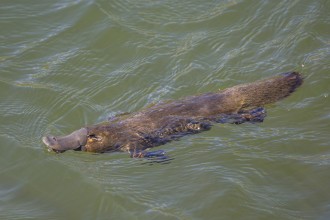The Young Scientist: Monotremes
The Young Scientist: Monotremes
February 6, 2025By AILEEN O'CATHERINE

Not all mammals share the exact same characteristics. Mammals are known for bearing their young live, but a small group of unique mammals called monotremes (MON-oh-treems) lay eggs. These animals live in Australia and New Guinea and share other major characteristics with mammals, so that is how they are classified. Monotremes include the platypus and four spiny anteaters called echidnas that have body hair and are endothermic, meaning they keep a constant body temperature, just like other mammals. They also produce milk for their young like mammals, but how monotremes produce their milk differs, because it comes from milk-secreting patches on the skin rather than from nipples. Unlike mammals, monotremes have a cloaca, which is a single opening used for reproduction and for getting rid of waste. Other mammals have several openings for these functions. (Monotreme means “single opening” in Greek.)
The duck-billed platypus is a monotreme that lives in eastern Australia and Tasmania. It is semiaquatic and has a flattened head and body and waterproof fur that helps it navigate rivers and waterways. It looks a bit like a beaver but weighs only about 2-6 pounds (1-3 kilograms) and is about 15-19 inches (40-50 centimeters) long with a 5-inch tail. Its snout looks like a duck’s bill but is soft and has many receptors that help it find prey.
Platypuses are shy bottom feeding carnivores that eat insects, larvae, shellfish and worms that live in the sediment. They store their food along with gravel and mud in their cheek pouches. Because they have no teeth, they use the stored gravel to help them “chew” their food through grinding. Like other monotremes, platypuses can find prey through electrolocation to help them “see” in cloudy water. Electrolocation is the ability for animals to detect electrical fields around them. Monotremes and dolphins are the only mammals with this ability.
The platypus is one of only a few venomous mammals. Male platypuses have sharp stingers on the heels of their rear feet that can shoot venom at their foes. Platypuses spend most of their time alone, either sleeping or eating. They are nocturnal, so they are mainly active at night. Baby platypuses are called puggles. When they hatch, they are completely blind and hairless.
Echidnas (i kid ne) are also monotremes. These spiny anteaters have long or short snouts that end in a tiny, toothless mouth. An echidna’s spines are actually rigid hairs, not spines. Echidnas can be found in the forests and woodlands of Australia, Tasmania and New Guinea. They shelter in brush piles, hollowed logs or dens dug by other animals. Adult echidnas can be from 14 to 21 inches (45-78 cm) long and can weigh between 5 and 22 pounds. They eat ants and termites by poking their snouts into logs and anthills, where they lick up their prey with long, sticky tongues. Echidnas with longer snouts eat worms and larvae. Like the platypus, they have no teeth, so they grind their food. They have short limbs with claws and are powerful diggers. Echidnas live on land but are good swimmers. Short-beaked echidnas look a bit like hedgehogs.
Some echidnas live in extremely hot environments. When temperatures rise to 95 degrees Fahrenheit, they stay cool by blowing snot bubbles at the ends of their snouts. The snot bubbles pop and moisten the echidna’s nose. That draws heat from a blood-filled cavity in the snout, and as the moisture evaporates, the animal’s blood cools down. Echidnas hide in piles of leaves or grasses or crawl into underground burrows to escape predators such as dingoes, eagles and foxes. Female echidnas carry their eggs in a pouch, and baby echidnas are called puggles. After spending several months in its mother’s pouch, a puggle emerges looking like a tiny adult.




